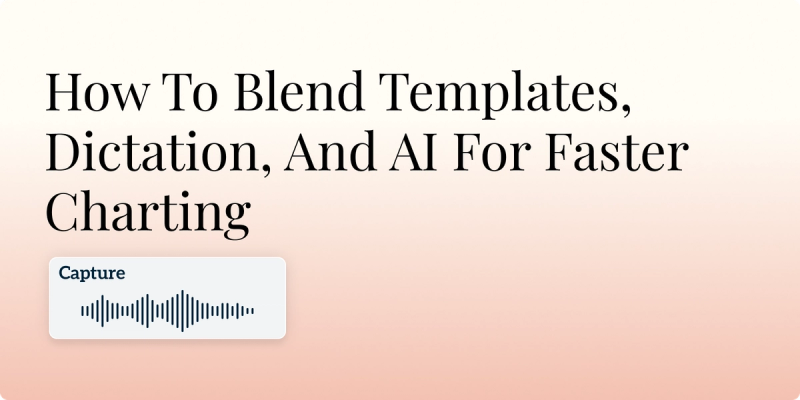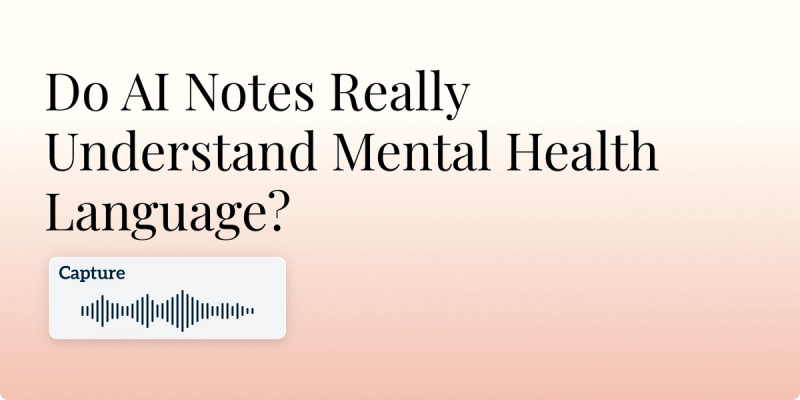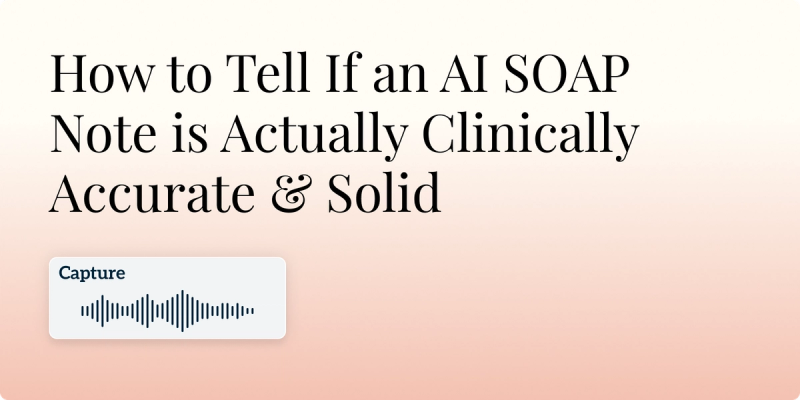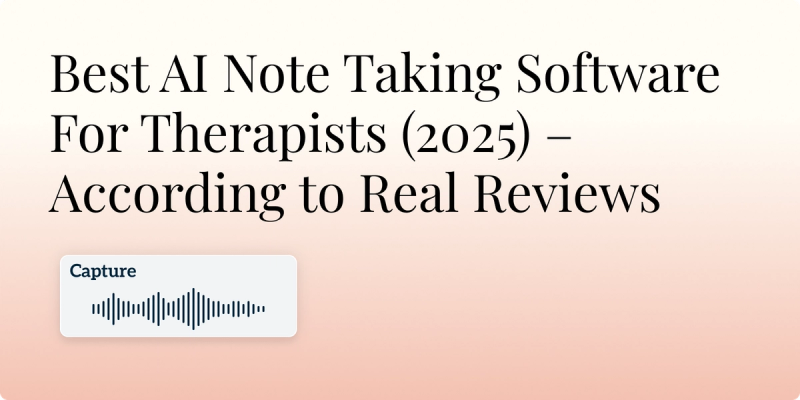
How To Blend Templates, Dictation, And AI For Faster Charting

If you're like most clinicians, you spend upwards of 15 hours a week on documentation, time that is increasingly stolen from patient care or personal time. The common approach is to juggle disparate tools: rigid templates that cant capture nuance, dictation that leaves you editing for accuracy, and AI scribe that feels like just another complicated system.
The solution isn't to choose one, but to strategically combine them. This guide provides a technical roadmap for using AI for faster charting by seamlessly blending templates and dictation into a single, efficient workflow to improve accuracy and reclaim hours of your week.
Laying The Foundation With AI Clinical Templates
Before you can chart faster, you need a better map. That's where AI clinical templates come in, providing the structured foundation for your notes.
Think of it this way: a generic note is like a blank sheet of paper, while an AI clinical template is a well‑designed form with all the right boxes already laid out. Your job becomes simply filling in the details, not building the framework on the fly.
Here's How To Build A Powerful Template Library
1. Get Specific: Ditch The One-Size-Fits-All Approach
Stop using the same generic template for every patient. The biggest time‑saver is creating templates for your common visits.
- Instead of a “Generic Follow-up” Template, create a “Hypertension Follow-up” that already has sections for today's BP reading, medication review, and diet/exercise notes.
- Instead of a broad “New Patient” Template, create a “Diabetes Management” template with dedicated spaces for A1C results, foot exam findings, and insulin dosing.
This small upfront investment saves you minutes per note by removing the need to constantly delete irrelevant sections and add missing ones.
2. Make them ‘Smarter’ with Auto-fill
A truly smart template does some of the work for you. The goal is to auto‑populate any existing information, allowing you to focus solely on what's new.
- In Practice: Your template can be set up to automatically pull in the patients' known allergies, current medications, and problem list directly from their EHR record.
- Before the Visit: Use digital intake forms so that the patient's chief complaint and history flow directly into the note before you even enter the room. This means you start with a partially completed chart, not an empty one.
3. Standardize for Your Whole Team
Efficiency multiplies when everyone is on the same page. Using a shared set of approved templates across your practice creates consistency and makes cross‑coverage seamless.
- How to Do It: Have your team collaborate on a core set of templates for the most frequent visit type. Store them in a shared folder and agree to use them. This ensures every note has the essential information, improves quality, and makes finding information in a colleague's note effortless.
By building this foundation of smart, specific templates, you create a clear structure. This sets you up perfectly for the next step: using your voice to fill in the blanks with speed and nuance.
Capturing Nuance With Dictation
While templates provide the essential structure, your voice holds the critical details: the patient's story, your clinical reasoning, and the nuanced plan. Modern dictation is the fastest way to capture this, but when paired with AI, it becomes transformative.
Dictation: Your Tool for the Narrative
Think of dictation as your high‑speed input device for the parts of the note that cant be captured in a checkbox. Its primary role is to efficiently fill in the narrative sections of your smart template, like the “Subjective” history and your “Assessment & Plan”.
- Go for Seamless Integration: The key is to use dictation tools that work directly with your EHR. This allows you to speak your notes directly into the correct fields in real-time, avoiding the hassle of switching between programs.
- Acknowledge the Old Hurdles: Traditional dictation has its frustrations. It can stumble over complex medical terms, and the constant need to dictate punctuation (“period”, “New paragraph”) is a mental drain. This is where AI steps in to elevate the entire process.
The AI: Processing And Polishing
AI clinical notes are the missing link that turns raw spoken words into a polished, structured note. This is the core of using AI for faster charting. AI clinical notes act as an intelligent processor, transforming spoken words into a polished, structured note ready for your chart.
How AI Supercharges Your Workflow
- The Ambient Scribe: Imagine an AI tool that passively listens to your entire conversation with the patient. Tools like this can automatically generate a draft note by distinguishing between the patient’s history and your clinical findings. Your job then shifts from creating the note to simply reviewing and refining it, saving immense amounts of time.
- The Smart Organizer: This is the core of the blend. You can dictate a free-form summary, and AI, using clinical language understanding, will structure it for you.
- Your Dictation: “Patient presents with improved sleep on the current dose of amitriptyline, but rates lower back pain as a 6/10. We will increase physio to twice weekly and review meds next month.”
- AI’s Action: The AI identifies the key clinical concepts and populates your template:
- Assessment: Chronic back pain. Insomnia improved.
- Plan: Increase physical therapy to twice weekly. Continue amitriptyline at current dose. Follow up in 4 weeks.
This combination is powerful. You speak naturally, focusing on the patient and your clinical thoughts, while the AI handles the work of formatting, structuring, and even applying proper medical terminology. This moves you from simply transferring information to efficiently curating and finalizing a complete clinical note.
The Integrated Workflow: A Step-By-Step Guide
Adopting this new workflow is straightforward if you follow a few key principles.
Choosing Your Tools
Look for solutions that check these boxes:
- Deep EHR Integration: The tool should work inside your existing EHR without requiring you to switch between windows.
- Positive User Reviews: Learn from the experiences of clinicians in similar practices.
Security is Non-Negotiable
When evaluating any technology that handles patient data, ensure it:
- It is fully HIPAA-compliant and will sign a Business Associate Agreement (BAA), adhering to guidelines for AI in healthcare security.
- Uses enterprise-grade security measures, including end-to-end encryption.
- Has clear data governance policies about how your patient information is stored and used.
Start Small and Scale
You dont need to overhaul your entire practice at once. The most successful implementations follow this pattern:
- Pilot: Choose one or two common visit types (like follow-ups or annual wellness visits)
- Refine: Get comfortable with the process and adjust your templates based on your experience.
- Expand: Once you're confident, gradually roll out the method to other visit types across your practice.
Pro-Tip: Master the “clinical prompt” when using AI clinical notes that require input; a better prompt gets a better result. Instead of just dictating freely, provide context. For example:
Try: “Create a concise SOAP note for a follow-up. The patient has chronic lower back pain, reports improvement with physical therapy, and is tolerating current medication without side effects. Plan is to continue current management.”
By providing this structure and key details, you guide the AI to generate a more precise and clinically relevant draft, making your final review even faster.
This integrated approach doesn't just help you chart faster; it helps you chart smarter, reclaiming time and mental energy for what matters most: your patients.
Conclusion
By strategically blending these three elements, you create a powerful synergy that transforms your documentation from a chore into an efficient process. The AI clinical templates provide the essential structure, your dictation captures the nuanced clinical story, and the AI acts as the intelligent engine that connects and polishes the two.
This integrated approach moves you beyond simply juggling tools to mastering a unified system designed for speed and accuracy. The ultimate result is a significant.
Frequently Asked Questions
ABOUT THE AUTHOR
Dr. Eli Neimark
Licensed Medical Doctor
Reduce burnout,
improve patient care.
Join thousands of clinicians already using AI to become more efficient.

Do AI Notes Really Understand Mental Health Language?
Can AI in therapy truly understand mental health language? Discover what AI gets right, where it fails, and how to use it safely in your practice.

How to Tell If an AI SOAP Note is Actually Clinically Accurate & Solid
How to Tell If an AI SOAP Note Is Clinically Accurate & Solid - Key Indicators, Common Pitfalls & Best Practices for Patient Care

Best AI Note Taking Software For Therapists (October 2025) – According to Real Reddit Reviews
Discover the 7 best AI note‑taking tools for therapists in 2025, ranked by real Reddit reviews.

